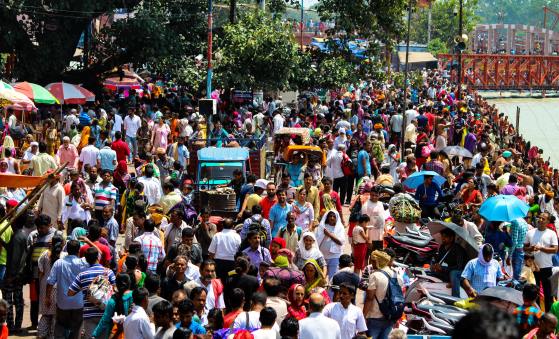Old Goa – The Archbishop of Goa, Filipe Neri Ferrao, in his homily addressed to the thousands of faithful that had gathered in Old Goa to venerate the relics of St. Francis Xavier on the occasion of the 43–day long 16th solemn Exposition from Nov. 21 till Jan. 2, has urged everyone not to forget the theme of the Exposition.
Speaking in Konkani and English, the Archbishop exhorted the believers to follow St. Xavier’s simplicity and concern for fellowmen. “St. Xavier followed in the footsteps of Jesus and gave up his nobility and riches to live a simple life, serving the sick and poor.”
“The Spanish saint rang a bell as he walked along these very streets of Goa, teaching catechism to the children who followed him,” the prelate said. “He worked tirelessly to bring on the right path those who led a bad life,” he added.
“Although he was the representative of the Pope, the saint lived in the servants’ quarters. He adopted a reconciling attitude towards sinners and worked towards bringing a change in their lives,” the Archbishop said.
Giving a call to the devotees of St. Xavier “to make it a point during this Exposition to strengthen our faith and grow in the love of Jesus to build a society of justice, love and peace,” the Archbishop urged everyone to follow the “shining example” of the 16th century saint.
Incidentally, this call has come in the wake of recent complaints by many that the Exposition is being touted as a tourist attraction.
In response to these allegations, the church authorities in Goa recently have announced that the exposition of the sacred relics of St Francis Xavier was not 'a tourist attraction' but 'a spiritual event' and those promoting it as an attraction for tourists were not aware of 'true depth of the event'.
"We would like to clarify that the exposition is not a tourist attraction as has been publicized in a section of the media. It is a deeply spiritual event and should be treated that way," Father Olavo Periera, in–charge of the media committee for the exposition, stated.
"Tourists will not come to Goa just for the exposition. Those who are promoting it as a tourism attraction do not understand the importance and solemnity of the event. It is their personal opinion and we have nothing to do with it," Father Periera clarified.
Church authorities, however, seemed to have no answer as to how the official brochure on the exposition published by the government has a great deal of tourism–related information that seems to have no relevance with the actual event.
The brochure contains details of 'important beaches' in Goa, tips for swimming safely and even names of state corporations with whom Goa Tourism Development Corporation (GTDC) has signed MoUs, all of which seem to have no relevance with the Exposition itself.
The brochure has been published jointly by the Department of Information and Publicity and the Goa Tourism and Development Corporation (GTDC.)
However, it seems to be true that indeed many visitors who have come to Goa during this time, are there only for the purpose of paying homage to the relics.
"People become emotional when they see the holy relic and many of them start crying," said Catholic priest Raymond Antao, a spokesman for the diocese of Goa.
"It is an occasion to deepen their faith," the priest said of the display, which began last Sunday.
As if to confirm the statement of the priest and to assert the solemnity of the purpose of their visit, many of the pilgrims said that attending the decennial exposition was their sole motive.
One of them, Jesuit Father Thomas Plastow, teaches at Saint Joseph's Theological Institute in Cedara, South Africa. He said that as a Jesuit, he is interested in the saint and has wanted to see the body of St. Francis Xavier, one of the order's founders.
"My journey to Goa is in keeping with a traditional link set up by Vasco da Gama, who made his voyage from South Africa to Goa," the priest said. Da Gama, a Portuguese navigator, opened the sea route from Europe to India.
Father Bentley Anderson from Georgia in the United States said that he felt "great to be able to get so close to the saint whom we have heard and taught so much about."
Missionaries of Charity Sister Dolorosa Diniz from Kanpur town in northern India said she prayed at the exposition for "everyone – the Holy Father, our Mother Superior Sister Nirmala Joshi and for the whole region." She said she felt "privileged to get a chance to be here for this exposition."
Saint Francis Xavier co–founded the Society of Jesus in 1534 with Saint Ignatius of Loyola and eight other companions. In 1542 he reached Old Goa, then the main Portuguese center in India and a base for evangelization.
The missioner, who preached in several places in Asia, died on an island off the coast of China before he could fulfill his desire to preach there too. His body was brought to Goa in 1554, and housed in Bom Jesus Basilica from 1637.
He was beatified in 1619 along with Ignatius and was canonized three years later. In spite of never having been embalmed, the body of Saint Francis Xavier has remained intact for centuries, but has deteriorated in recent decades. The Jesuits now consider his remains a relic.
The casket containing the remains of the saint is usually placed high up in an altar of Goa's Basilica of Bom Jesus. But in a ceremony held every 10 years since 1964, it is taken in a procession to the more spacious Se Cathedral across the street where it is displayed for pilgrims to take a closer look.
The first public display of the body of the saint was in 1782, prior to which only important government officials had been allowed to see it.




